 Abraham Lincoln
If given the truth, the people can be depended upon to meet any national crisis...
Abraham Lincoln
If given the truth, the people can be depended upon to meet any national crisis...
 Guildford news...
for Guildford people, brought to you by Guildford reporters - Guildford's own news service
Guildford news...
for Guildford people, brought to you by Guildford reporters - Guildford's own news service
Birdwatcher’s Diary No.205
Published on: 8 Apr, 2020
Updated on: 8 Apr, 2020
By Malcolm Fincham
Finally! By the last weeks of March a settled spell of weather arrived around the southern areas of the UK.
With high hopes, I planned ventures out and about to meet and greet some of our summer birds that should soon be arriving. Some already having been reported on coastal resorts in the southern-most counties.
My thoughts of ventures were dashed. The coronavirus had beaten the main influx of summer visiting birds with its own arrival to our shores. And the lockdown had been imposed.
Although indispensable workers were able to continue with their jobs, and essential food shopping still allowed, leisure activities, such as cycling, jogging and walking, had been limited to one trip a day as long as it was less than 2km from one’s home.
Hopes and schemes have become merely dreams in what is turning out to be a curious year indeed. It was time to get my ducks in a row, perhaps?
It had allowed me one last trip to Effingham forest that I didn’t get the opportunity to write about in my previous report.
It certainly felt as if spring had sprung that day as I walked along the main forest track. The sun filtered though the pines and deciduous trees not yet in leaf, trapping its warmth in the areas where it shone.
Butterflies had begun to emerge from the sun traps.
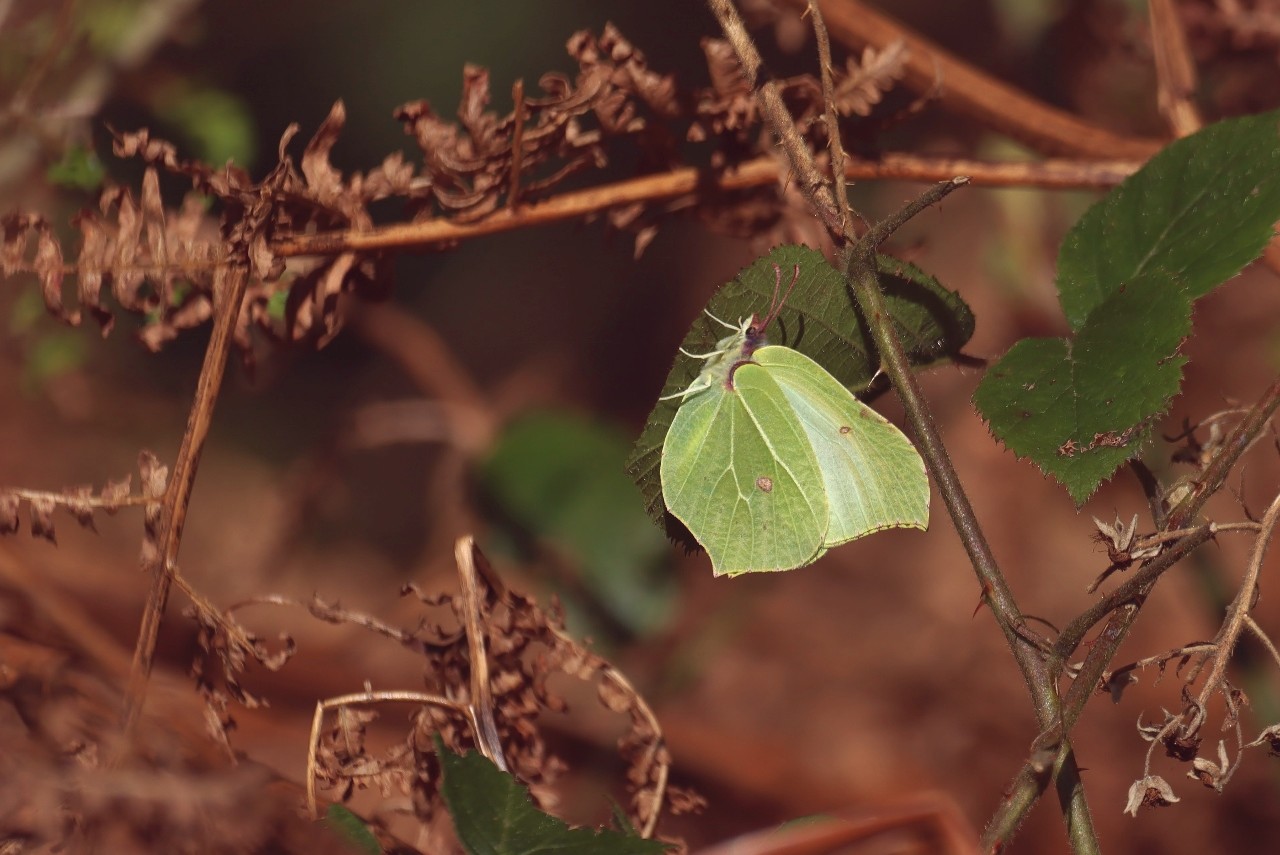
Brimstone butterfly at Effingham forest. Click on pictures to enlarge in a new window.
Mostly seen where brimstone butterflies, their colour denoting what is thought to be where the origin of the name butterfly came from.
A handful of peacock butterflies also added to the day’s sightings.

Peacock butterfly at Effingham forest..
As well as a few comma butterflies.
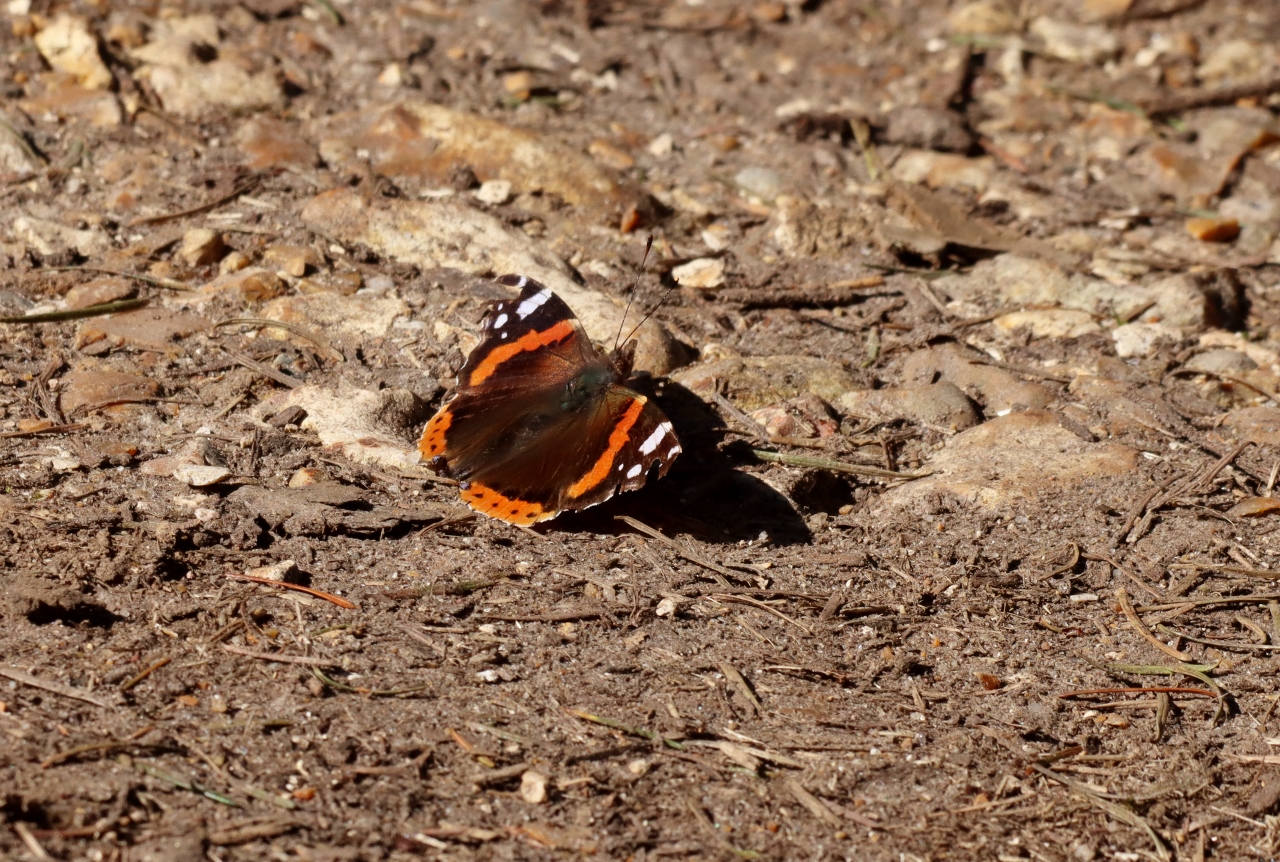
Red admiral butterfly at Effingham forest.
A red admiral.
The sound of chiffchaffs in song was truly elevating one’s soul.
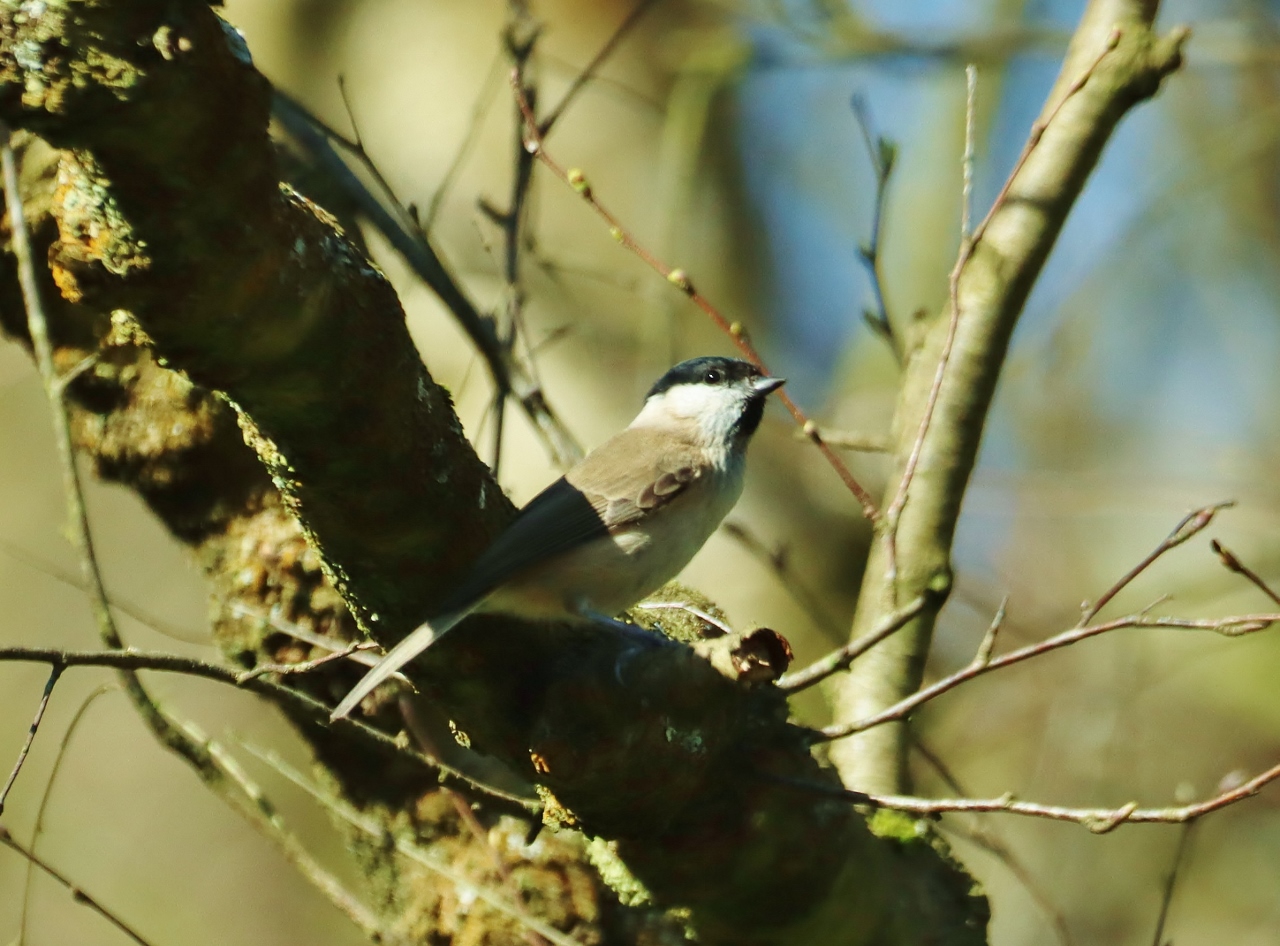
Marsh tits pairing up in Effingham Forrest.
Several marsh tits could now be seen paired up, chasing and calling to each other.
At the tops of the pines coal tits could be seen feeding.
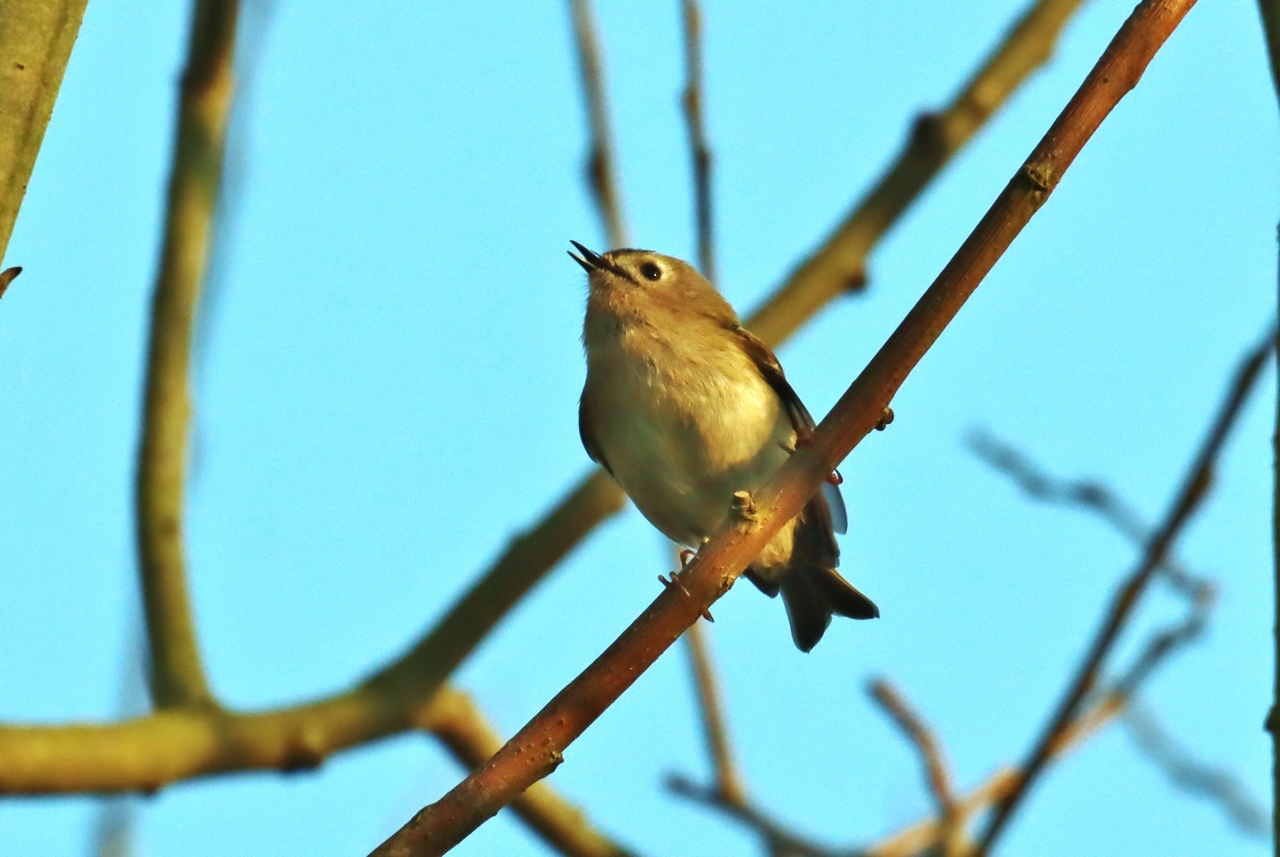
Goldcrest, this one at the Riverside Nature Reserve.
While goldcrests made themselves a little easier to photograph as they flitted around in the lower foliage.
My prize photos that day were a selection of several firecrests that could be heard and seen displaying.
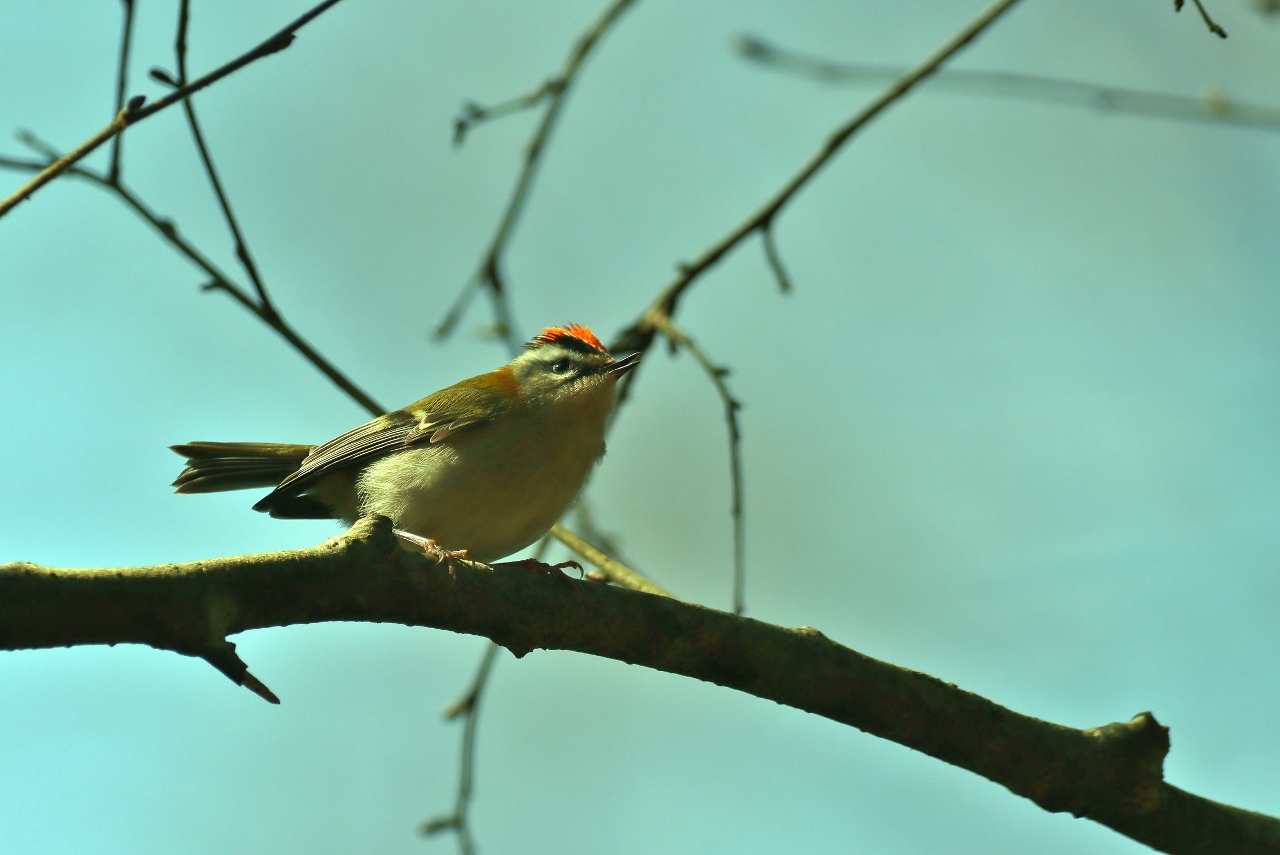
Firecrest in Effingham Forest.
Like the goldcrest, the firecrest’s scientific name has a royal ring to it. Regulus ignicapilla. It translates roughly as the fire-capped little king, a reference to the beautiful orange crown of the male.
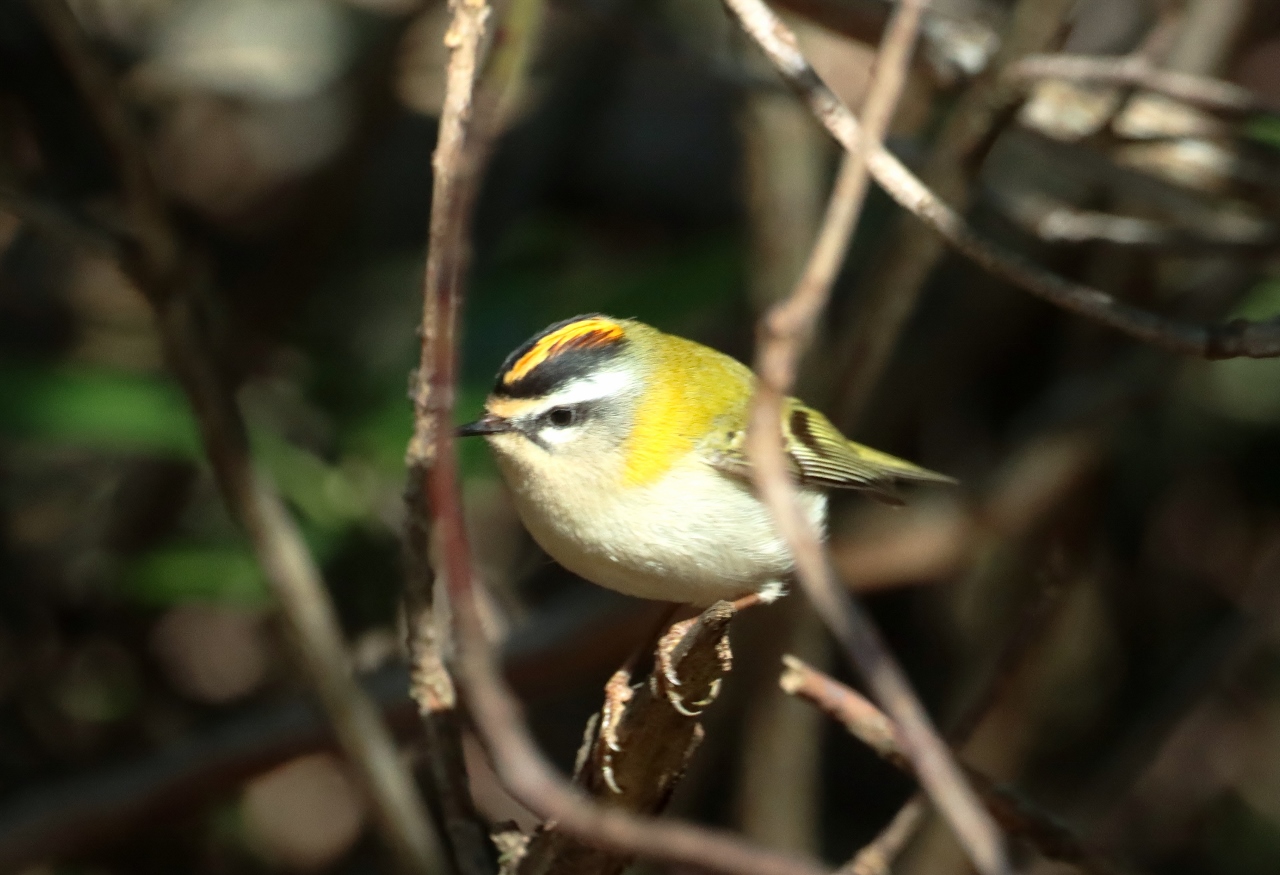
Firecrest in Effingham Forest.
Males have a bright orange crown edged with black, while the female’s crown is yellow.
The firecrest’s most distinctive feature is a bright white line above the eye, which is not present in goldcrests. The tiny firecrest vies with the goldcrest for the title of the UK’s smallest bird.
Once just a visitor, they were first recorded breeding in the UK in Hampshire in 1962, and now can be found in coniferous forests throughout much of southern England.
Adding to my species sightings for this year were four hawfinches, which flew overhead, unfortunately too quickly, on this occasion, for my lens to focus on.
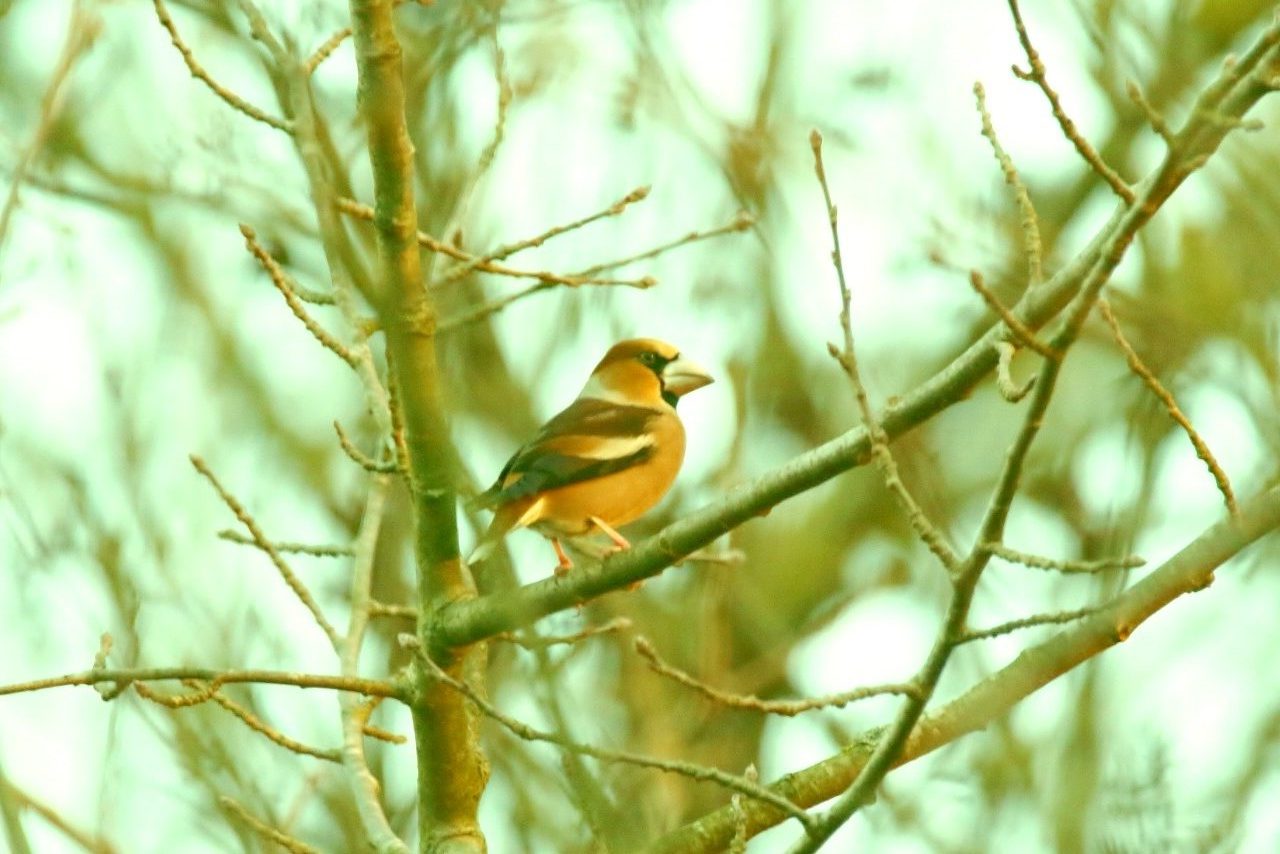
Hawfinch, photo taken on a previous occasion.
At Britten’s Pond, off Salt Box Road, Guildford, the course fishing was in close season. with no fear of disturbing any anglers, I took a stroll around what was, a quiet lakeside.

Carp jumping at Britten’s Pond.
The still waters were interrupted by the occasional carp jumping.
Quite a common sight to see (if patient to watch for long enough).
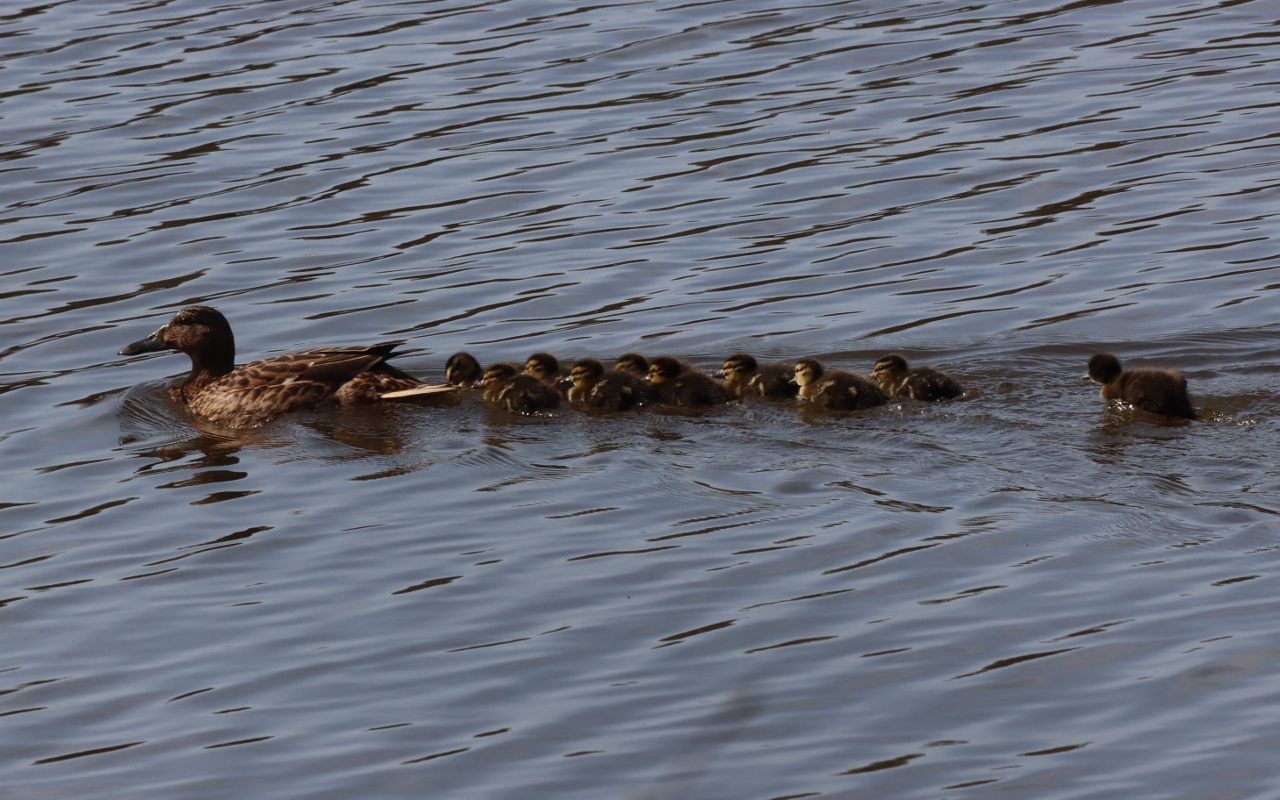
Mallard with chicks on Britten’s Pond.
On March 23, an early hatching of mallard chicks could be seen on Britten’s Pond. They frantically paddled to keep up with their mum as she paraded them around close to the water’s edge to avoid possible predation.
Just a few days later, however, not only had Britten’s Pond car park had been closed, but Whitmoor Common car park was also barred from use.
As the noose began to tighten for dog walkers and nature lovers alike, the places to walk continued to lessen. Suffering from anxiety, as I do, I could feel myself shaking within. (Not good when using my camera, even with optically stabilized lenses).
How can this be? Driving on my own to places where seldom a soul is seen to get some exercise and listen to birds sing was now seriously impeding on one’s freedom. “This was more about control, with little thought to own personal health,” were my sceptical thoughts.

Our trusted canine companion!
Fortunately, it isn’t too far for me to walk to Whitmoor Common. Although it gave me less time for my observations, it did give me time to level my head and ease my mind before I got there. Often taking our rescued family canine companion for company.
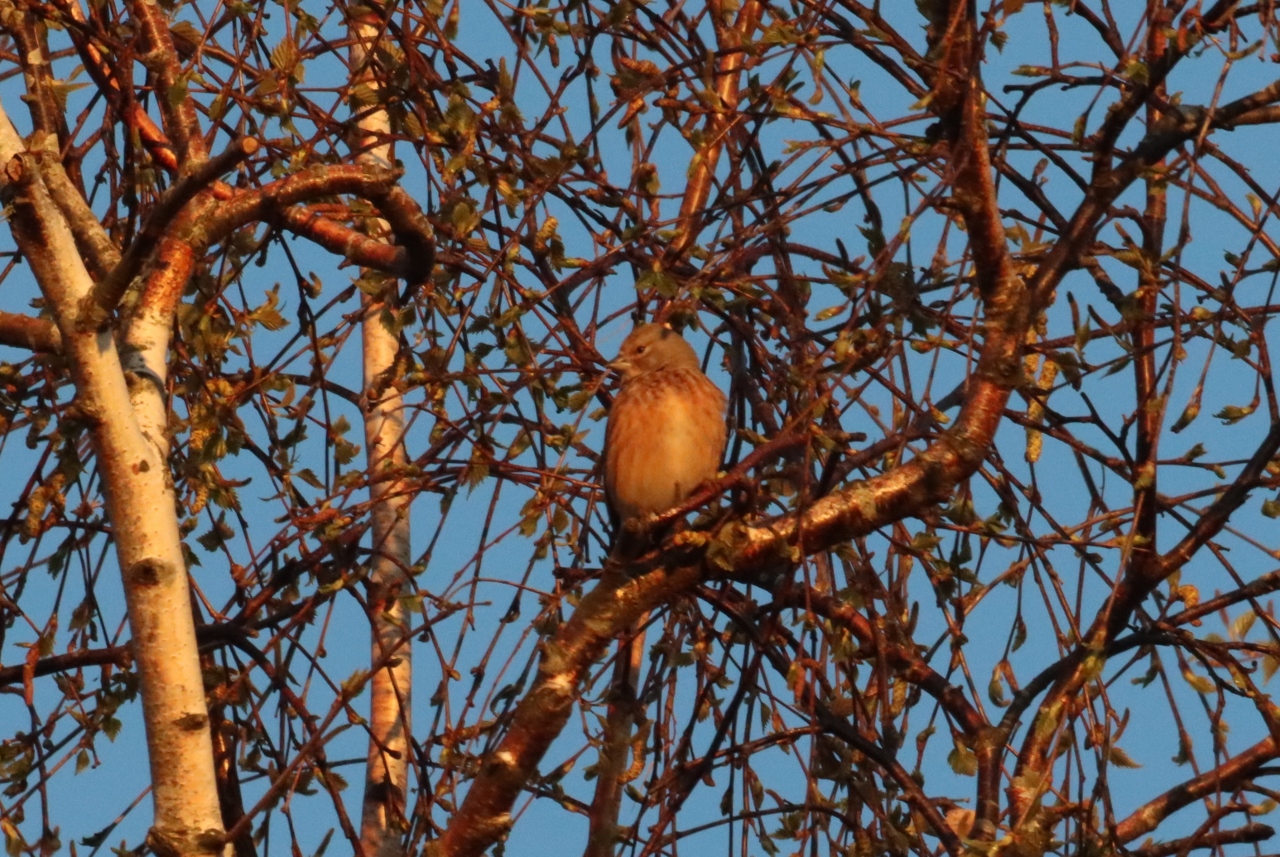
Linnet, Whitmoor Common.
A few linnets singing soon calmed my anxieties when I arrived.
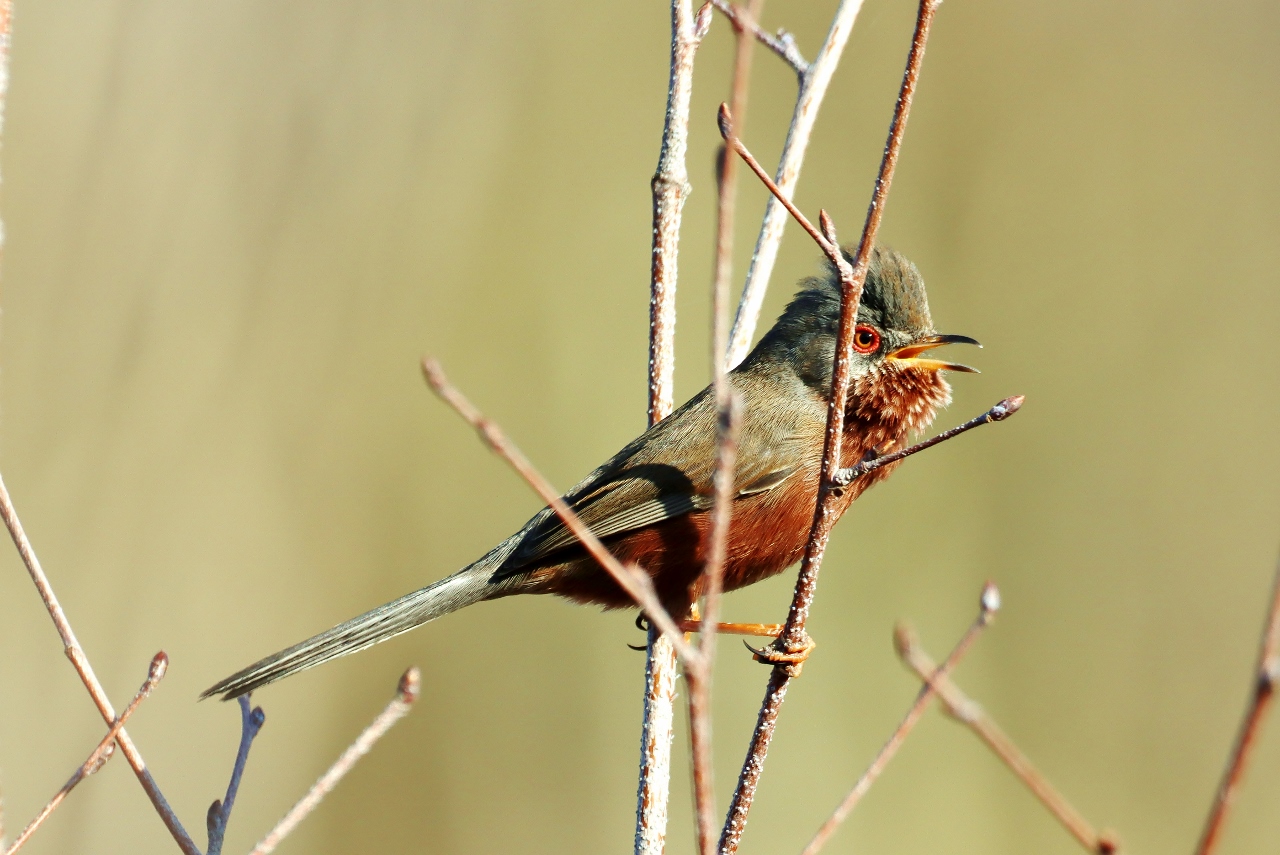
Dartford warbler on Whitmoor Common.
Dartford warblers continued to make their “scratchy” sounds, and occasionally I would catch sight of one as it perched up momentarily on the flowering gorse.
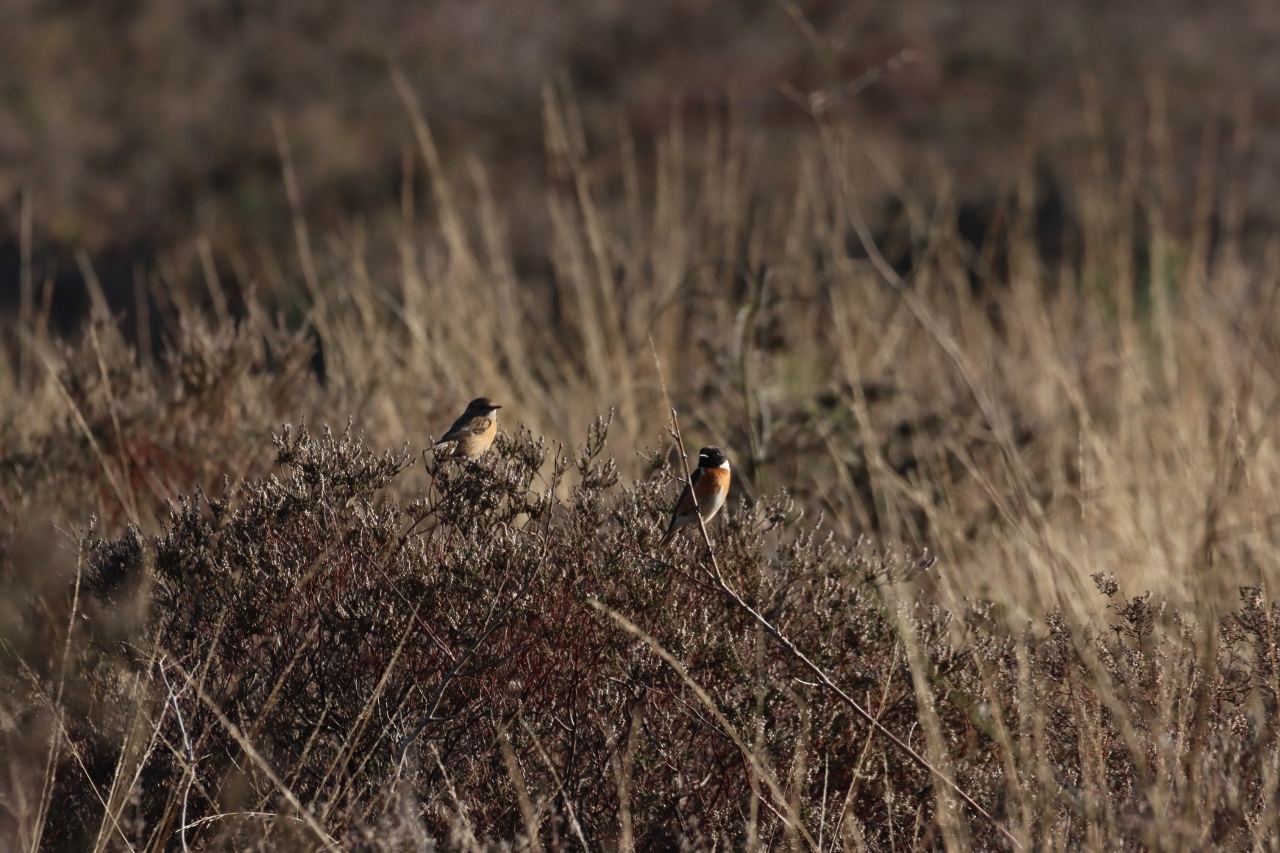
Stonechats on Whitmoor Common.
Stonechats, now paired up, were also on show on the heathland.

Redwings on Whitmoor Common.
On March 30, beyond the heathland in a paddock lined by trees, the “seep-seep” sound of redwings could still be heard. Counting 15 or so as they perched high in the branches. Hanging on perhaps for a southerly wind to assist them back to their breeding grounds in Scandinavia.

Treecreeper singing its little heart out on Whitmoor Common.
Treecreepers were among some of our resident birds that had already started nest building. Although small, well camouflaged birds, I was able to pick one out as it crept up a tree singing its little heart out, by what was now a car park strangely empty of vehicles.

Song thrush on Whitmoor Common.
While a pair of song thrushes rummaged around in some dead leaves searching for grubs.

Stoke Lake at the Riverside Nature Reserve.
On alternate days, and also within walking distance, was my local patch – the Riverside Nature Reserve.
Thankful to have places to birdwatch and with the dry pleasant spell continuing, as I was becoming almost as fearful of catching “cabin fever”, as I was coronavirus!
Being able to visit the nature reserve was keeping me sane! (Well, that and the pixies that regularly wave to me from the bottom of my garden).
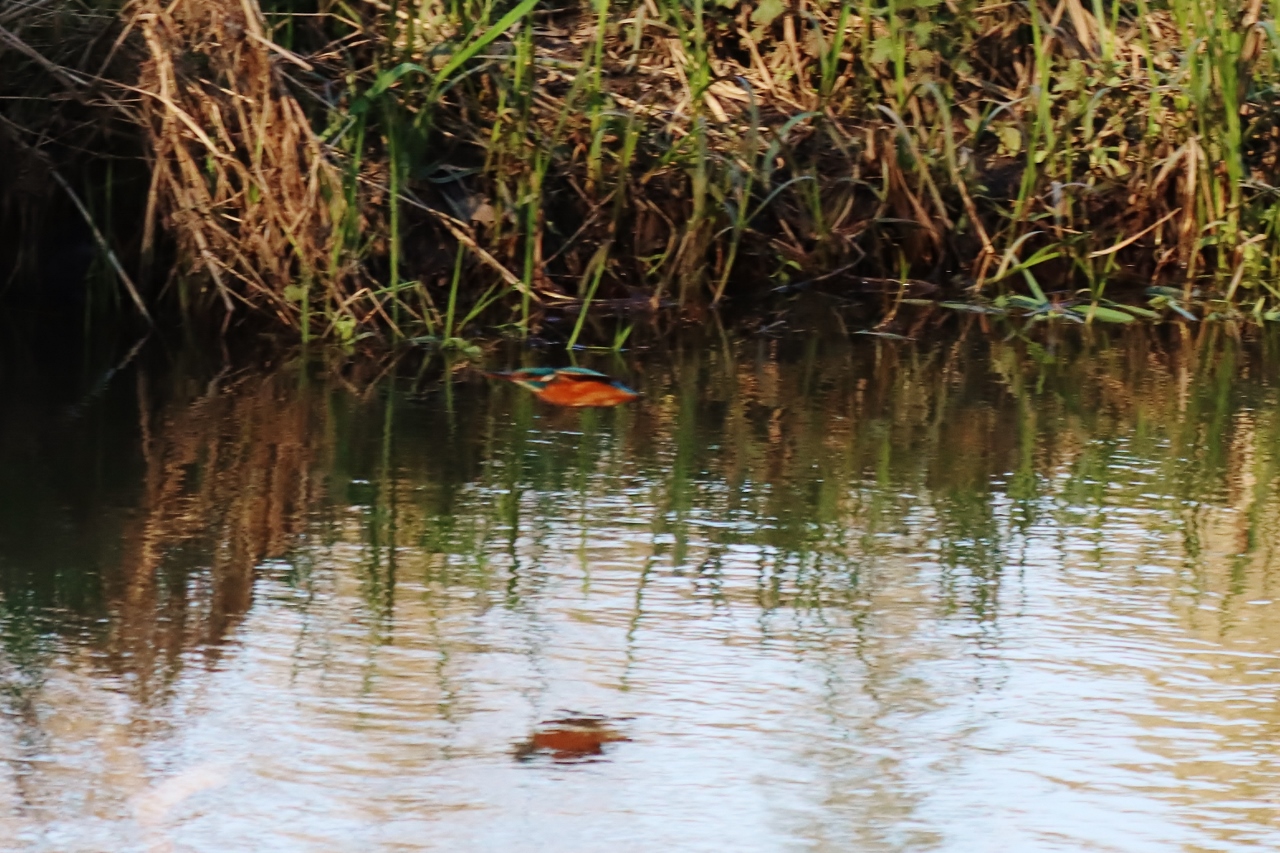
Kingfisher fly-by along River Wey near Bower’s Lock.
Although I hadn’t seen a kingfisher around the lakeside for a few weeks now, I did manage a lucky shot of one near to Bower’s Lock, at the Burpham end of the River Wey. Hopefully now now paired up and producing young in one of the quieter parts of the Wey Navigations.

Small tortoiseshell butterfly at Riverside Nature Reserve.
The weather was just about warm enough for a few butterflies to start to emerge there on March 24. Among the brimstones and peacock butterflies was my first small tortoiseshell.
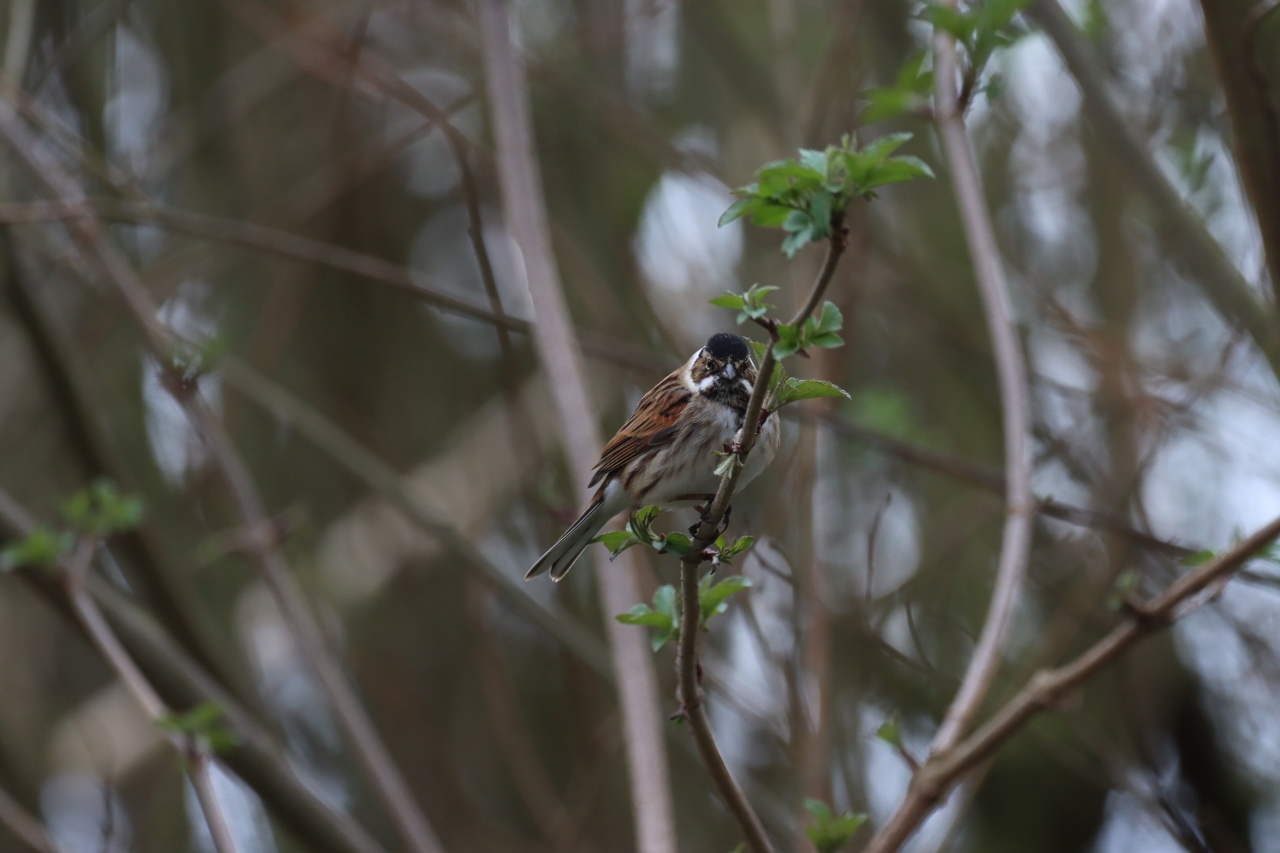
Reed bunting.
It wasn’t until after the middle of the month that I saw my first reed bunting at the reserve.
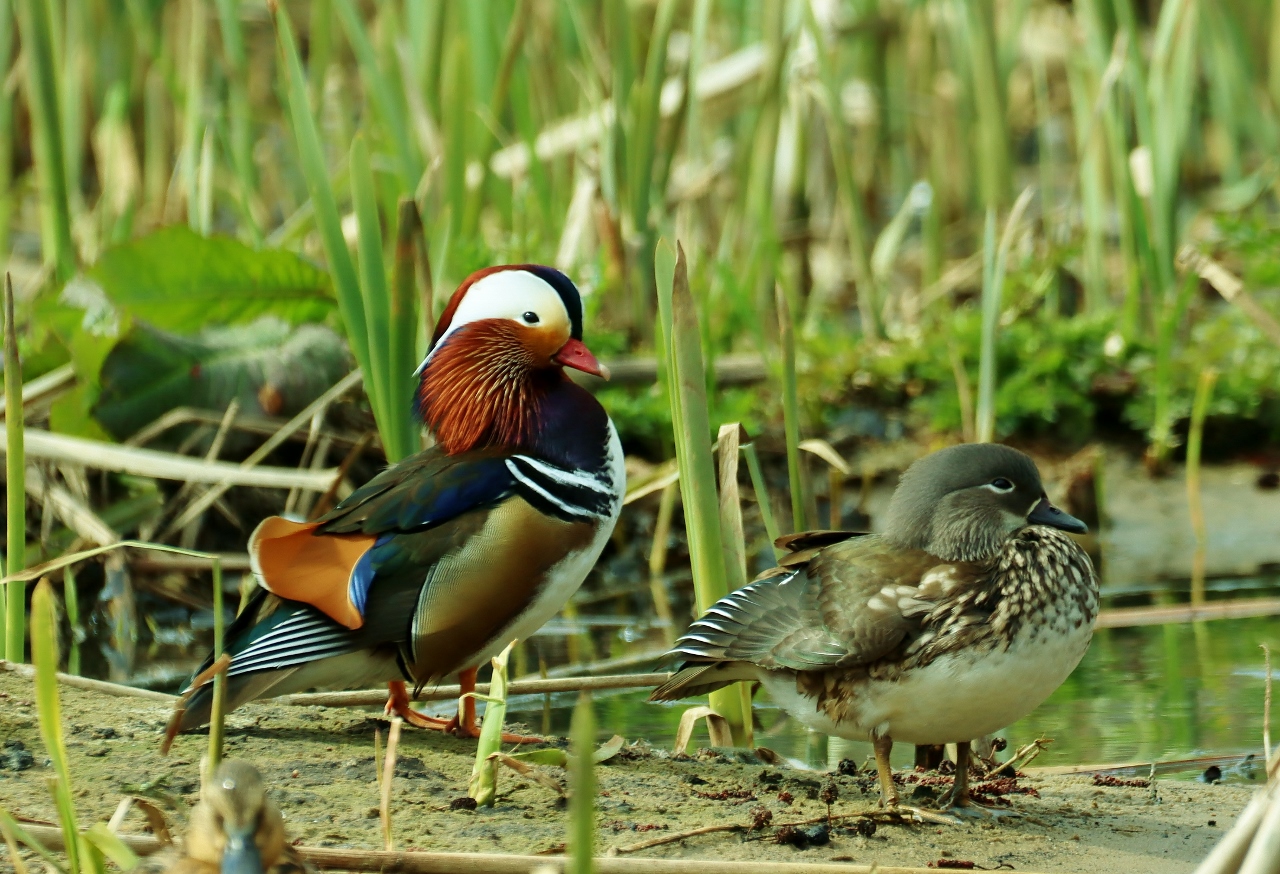 On a couple of my visits, from the towpath of the River Wey, I was able to get photos of an obliging pair of mandarin ducks. This included some really confiding views of them on March 31.
On a couple of my visits, from the towpath of the River Wey, I was able to get photos of an obliging pair of mandarin ducks. This included some really confiding views of them on March 31.
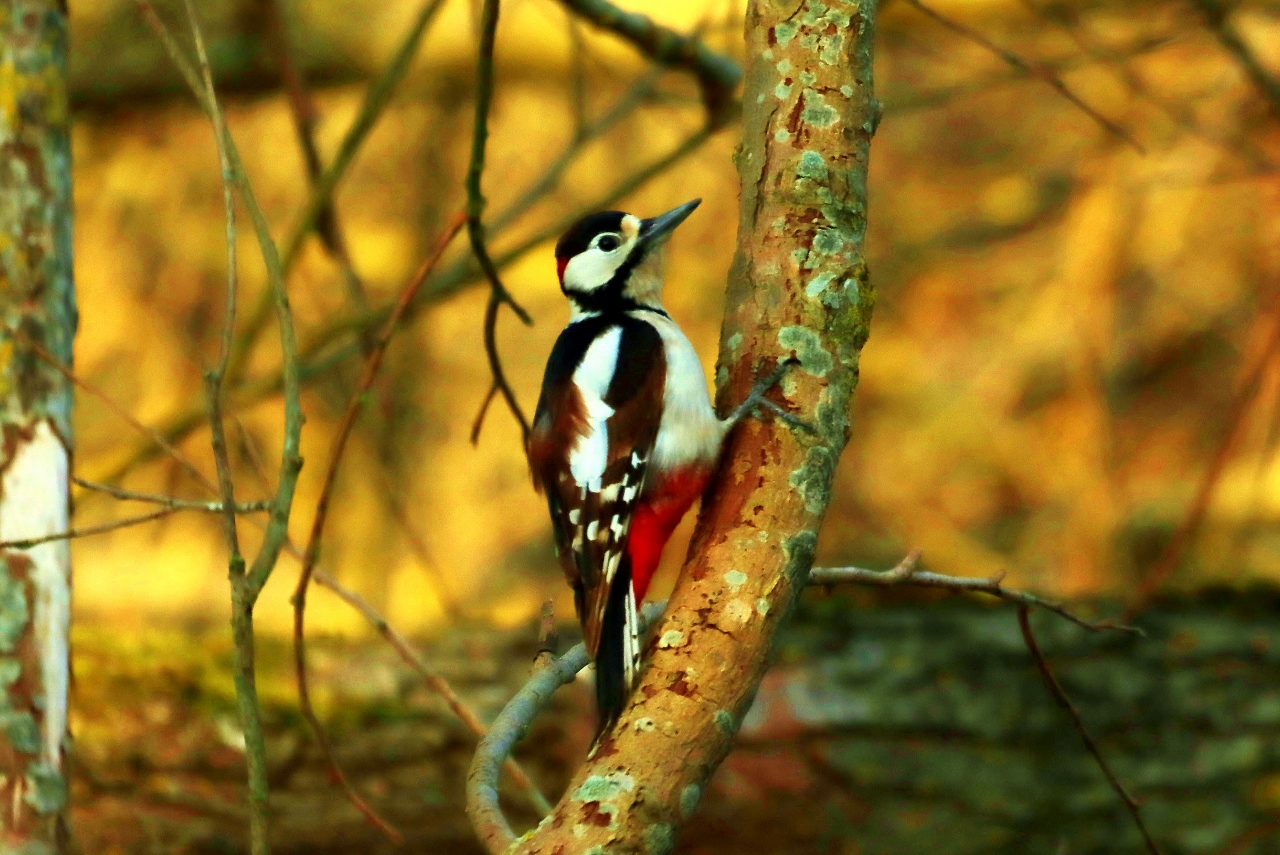
Great spotted woodpecker at the Riverside Nature Reserve.
As I walked the towpath I was alerted to the sound of a great spotted woodpecker, drumming on a tree, close by.
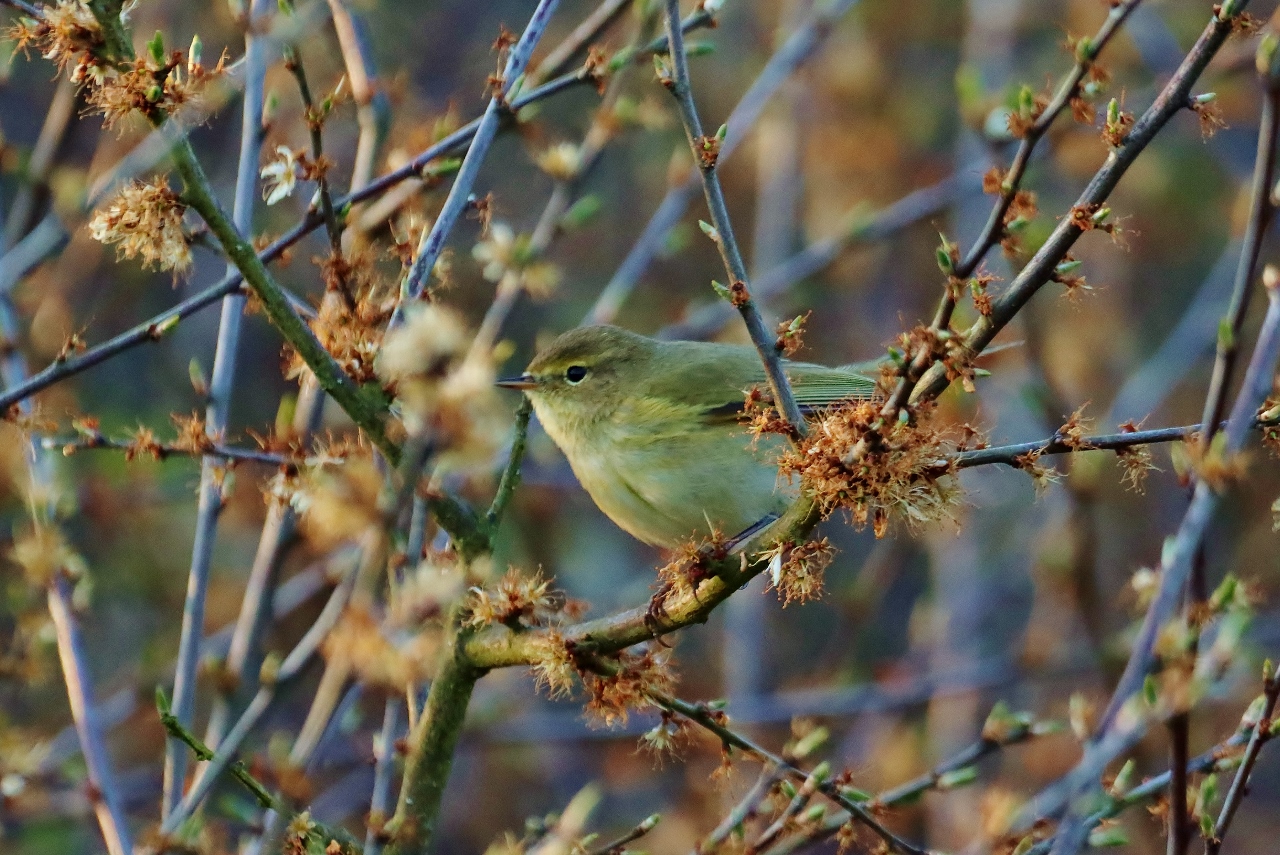
Chiffchaff at the Riverside Nature Reserve.
As at Whitmoor Common, treecreepers could be heard in song. While chiffchaffs in song were abundant.
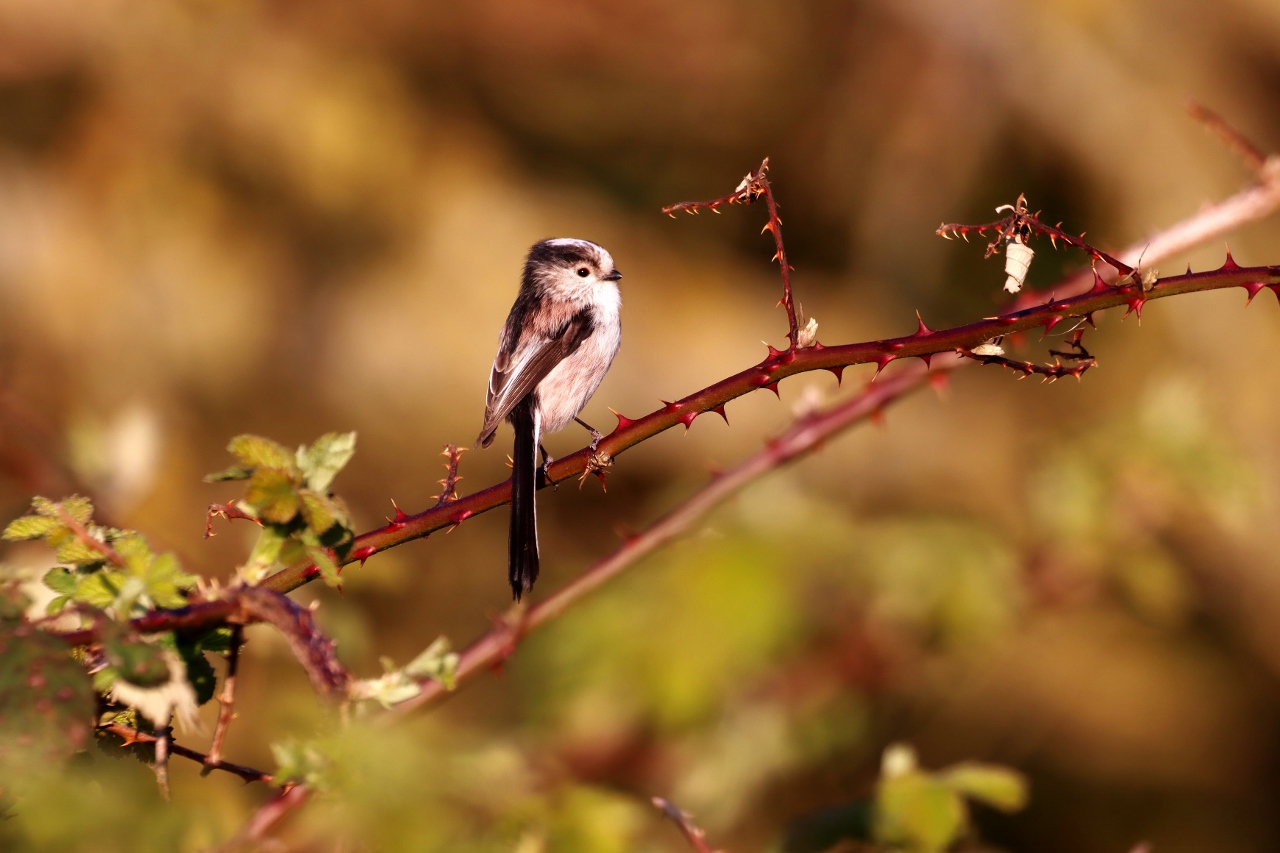
Long-tailed tit at the Riverside Nature Reserve.
Long-tailed tits were now paired up and busy building their nests deep within the “hopeful” safety of the prying eyes of predators, deep within the brambles.
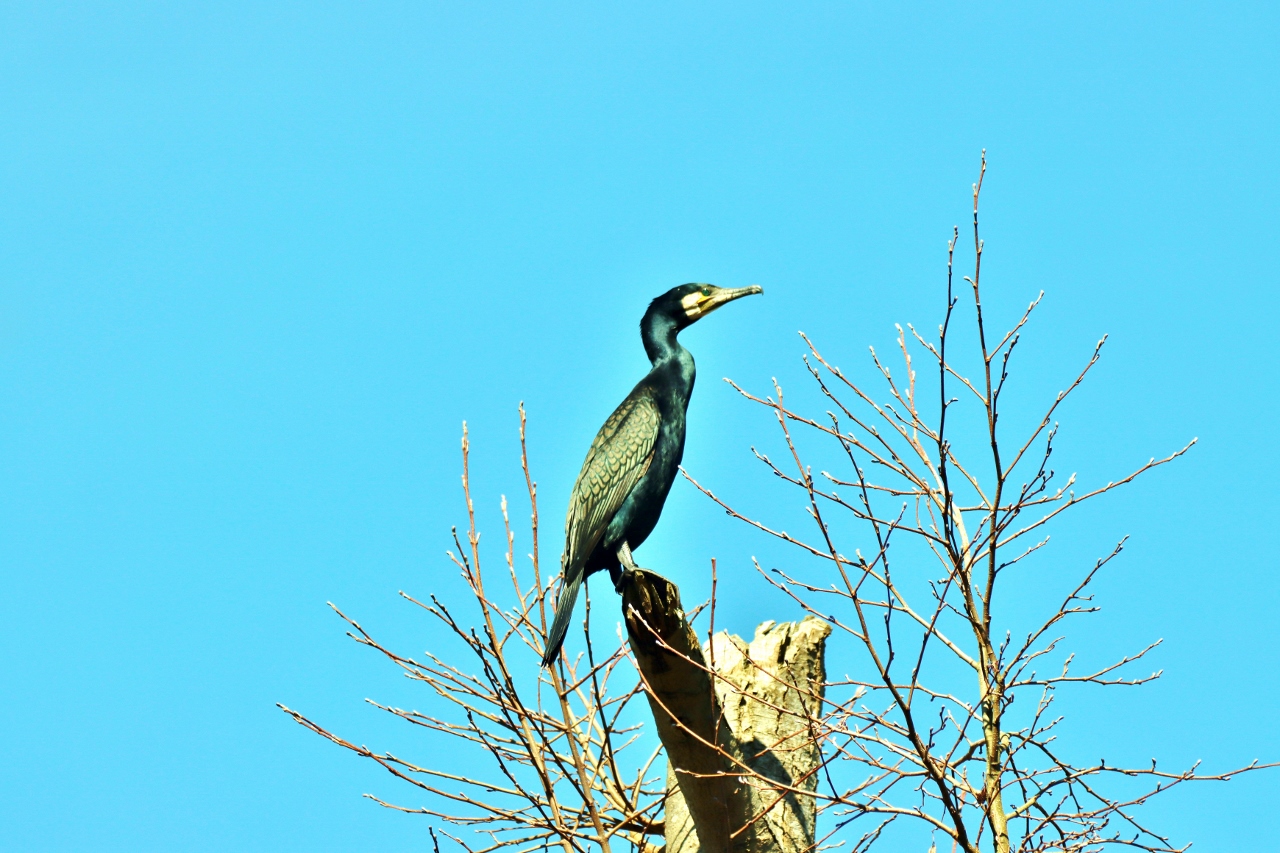
Cormorant.
Cormorants continued to be a common sight, often counting at least four or five.
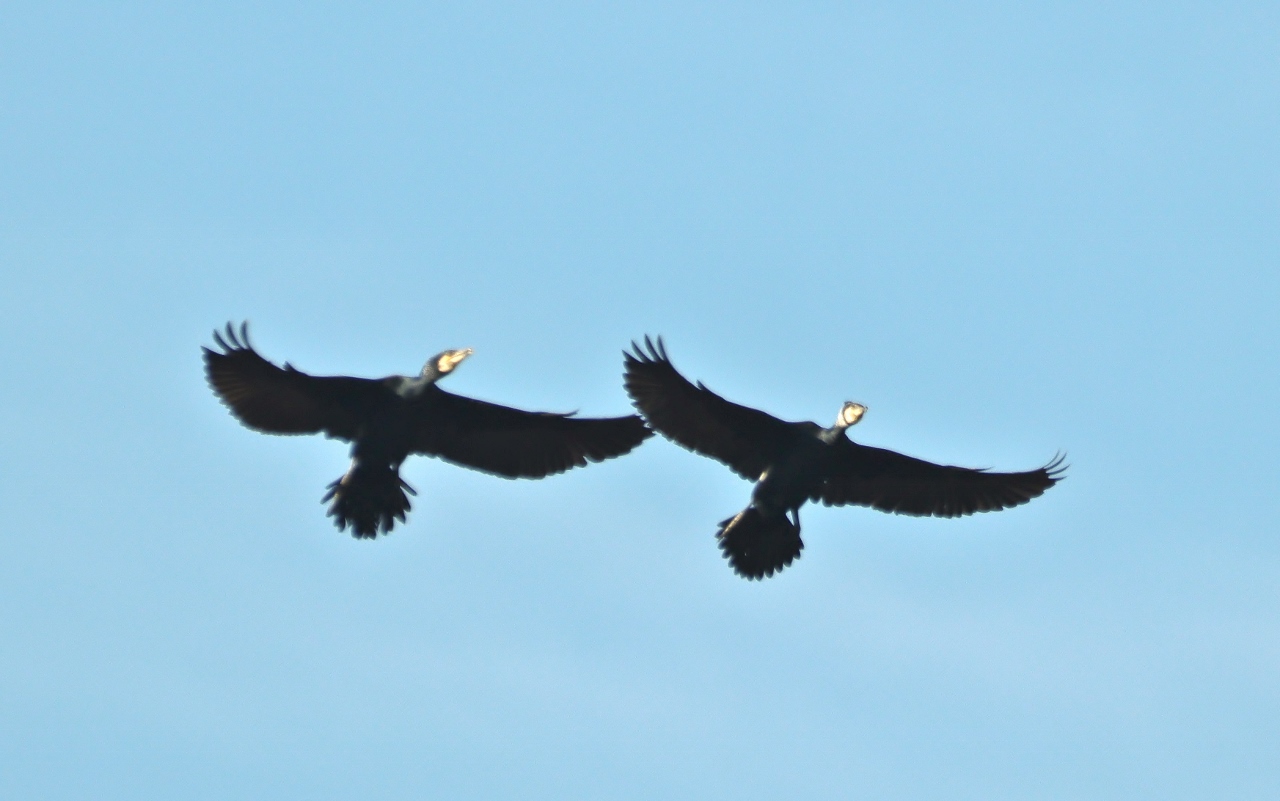
Cormorants at the Riverside Nature Reserve.
Mostly seen in flight, though occasionally fishing in the river or lake.
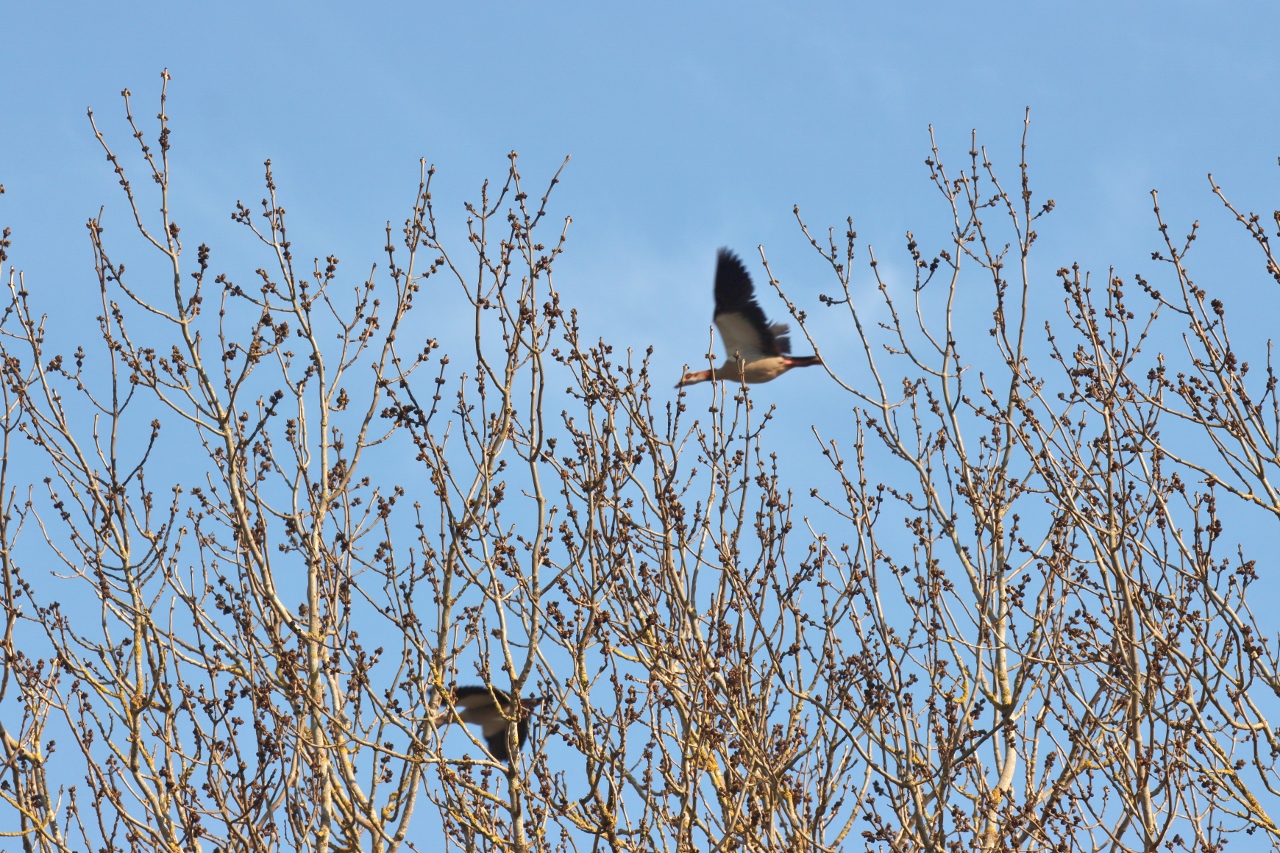
Egyptian geese at the Riverside Nature Reserve.
Other common sightings recently have been Egyptian geese.

Common buzzard at the Riverside Nature Reserve.
Common buzzards can often be seen circling over the fields.
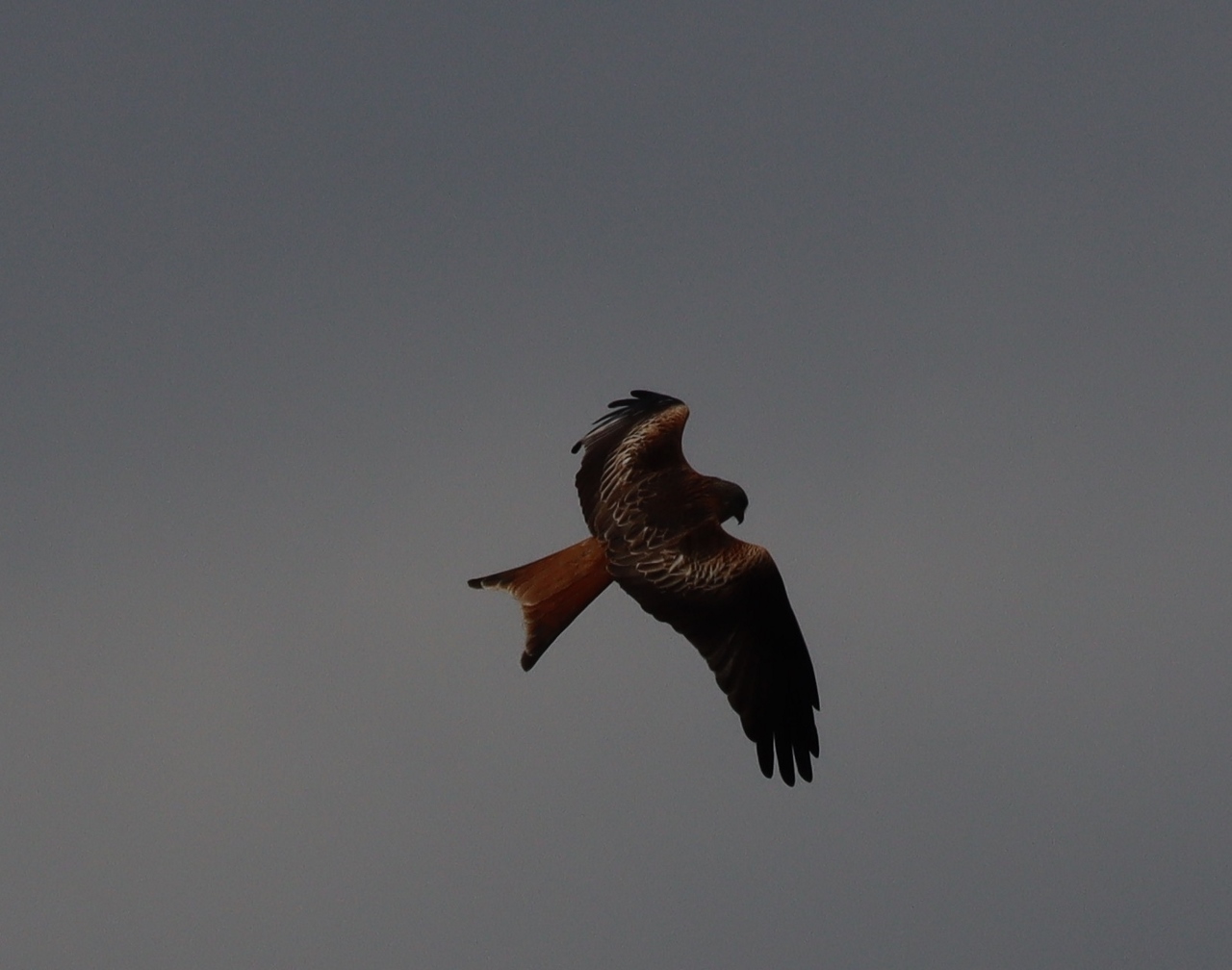
Red kite at the Riverside Nature Reserve.
While at least one red kite can be viewed during most of my visits. Most regularly over the nearby recycleing depot, though occasionally drifting over the lake.
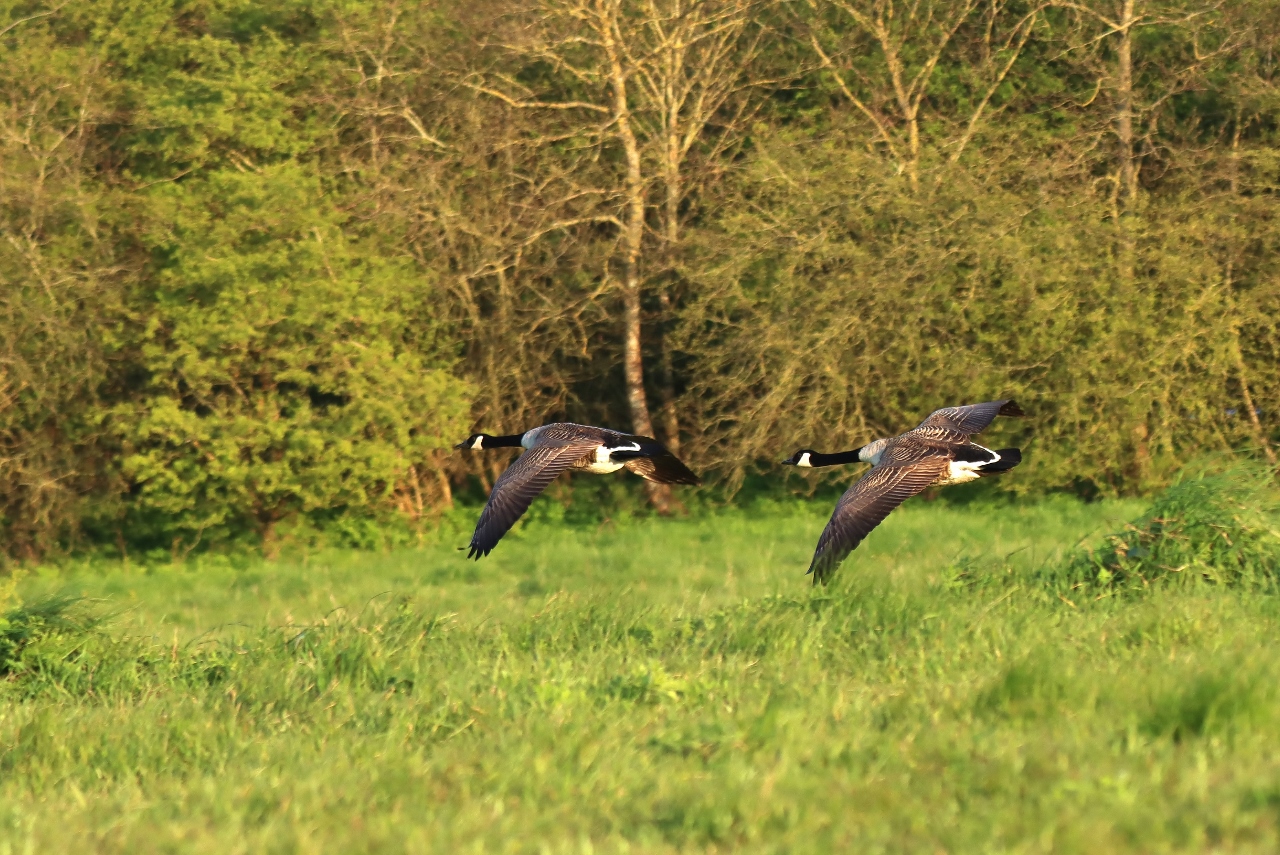
Canada geese at the Riverside Nature Reserve.
Canada geese, of course, continue to be very much a resident bird there, although fewer in number at this time of the year.
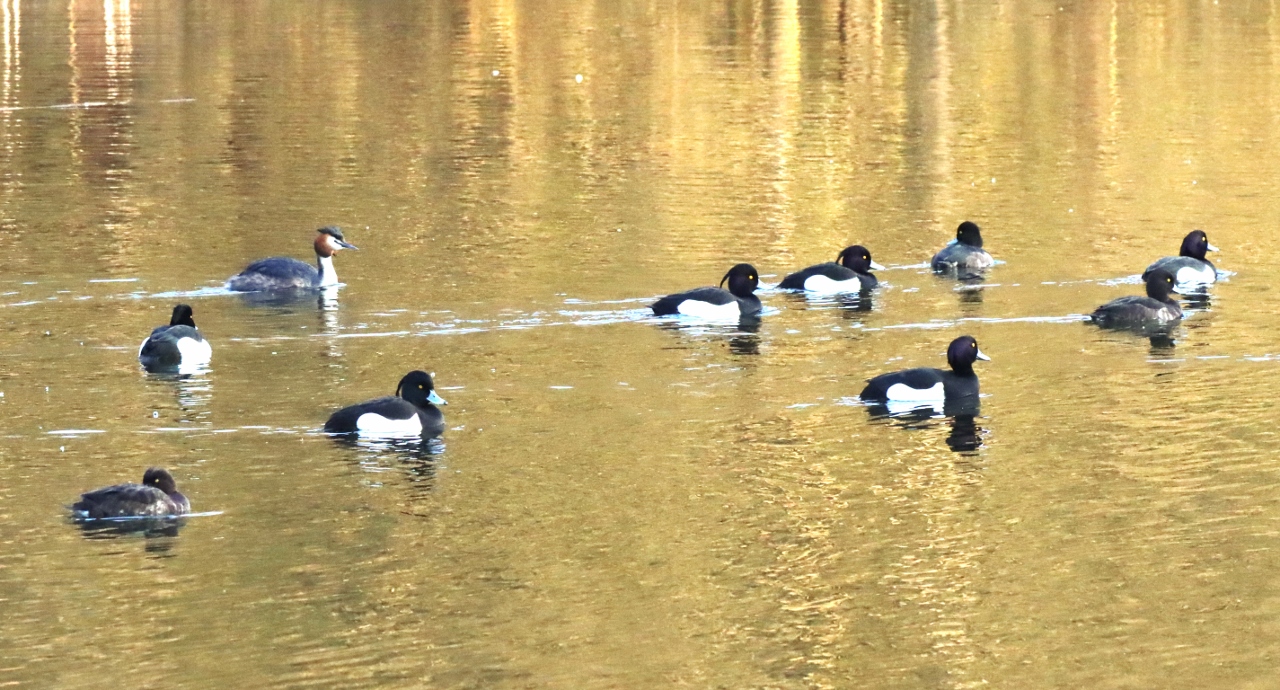
Tufted ducks on Stoke Lake.
A recent count by me of the tufted ducks on Stoke Lake reached a tally of 18. These will soon dwindle in number as they fly to their more northerly breeding grounds.
“Nobody told me there would be days like these!” Strange days indeed, strange days indeed.
Responses to Birdwatcher’s Diary No.205
Leave a Comment Cancel replyPlease see our comments policy. All comments are moderated and may take time to appear.

"Found any?" - "Nope, it all looks green to me!" (See Opinion: The Future is Congested, the Future is Grey)
www.abbotshospital.org/news/">





Recent Articles
- Latest Evidence in Sara Sharif Trial
- Ash’s New Road Bridge Is Named – and November 23rd Is Opening Day
- Class A in Underwear Leads to Jail Sentence
- Historical Almshouse Charity Celebrates Guildford in Bloom Victory
- Notice: Shalford Renewable Showcase – November 16
- Firework Fiesta: Guildford Lions Club Announces Extra Attractions
- Come and Meet the Flower Fairies at Watts Gallery
- Updated: Royal Mail Public Counter in Woodbridge Meadows to Close, Says Staff Member
- Letter: New Developments Should Benefit Local People
- Open Letter to Jeremy Hunt, MP: Ash’s Healthcare Concerns


Recent Comments
- Paul Spooner on Ash’s New Road Bridge Is Named – and November 23rd Is Opening Day
- Harry Eve on Opinion: The Future is Congested, the Future is Grey
- Nigel Keane on Letter: New Developments Should Benefit Local People
- Nathan Cassidy on Updated: Royal Mail Public Counter in Woodbridge Meadows to Close, Says Staff Member
- T Saunders on Opinion: The Future is Congested, the Future is Grey
- Jim Allen on Updated: Royal Mail Public Counter in Woodbridge Meadows to Close, Says Staff Member
Search in Site
Media Gallery
Dragon Interview: Local Artist Leaves Her Mark At One of England’s Most Historic Buildings
January 21, 2023 / No Comment / Read MoreDragon Interview: Lib Dem Planning Chair: ‘Current Policy Doesn’t Work for Local People’
January 19, 2023 / No Comment / Read MoreA3 Tunnel in Guildford ‘Necessary’ for New Homes, Says Guildford’s MP
January 10, 2023 / No Comment / Read More‘Madness’ for London Road Scheme to Go Ahead Against ‘Huge Opposition’, Says SCC Leader
January 6, 2023 / No Comment / Read MoreCouncillor’s Son Starts Campaign for More Consultation on North Street Plan
December 30, 2022 / No Comment / Read MoreCounty Council Climbs Down Over London Road Works – Further ‘Engagement’ Period Announced
December 14, 2022 / No Comment / Read MoreDragon Interview: GBC Reaction to the Government’s Expected Decision to Relax Housing Targets
December 7, 2022 / No Comment / Read MoreHow Can Our Town Centre Businesses Recover? Watch the Shop Front Debate
May 18, 2020 / No Comment / Read More







Stephanie Goodall
April 9, 2020 at 9:53 am
I am a very regular dog walker and love nature, but having just looked at your beautiful pictures of birds and reading about where you photograph them, I’m gobsmacked.
How lucky we are to have these wonderful birds overhead so close to home.
Although I love to hear the birds chattering, I’ll now keep more of a lookout myself.
Wonderful, thank you.
Amanda Jane Sherwood
April 9, 2020 at 2:46 pm
I wish to thank Malcolm Fincham so much for his informative diary with amazing pictures. I just happened to stumble upon his diary and I’m so pleased I did as it is delightful. And to think it’s all on our doorstep. Thank you so much.
Chris Townsend
April 9, 2020 at 8:44 pm
Just recently, an irritating little blighter has been “singing” in our garden.
We live close to town, but have shrubs and hedges around us, an old cedar tree and a big oak.
The monotonous call of the unseen newcomer had us stumped until today, when I looked up “chiffchaff” in my “Observer’s Book of British Birds”. (The book is so old it has the name of my cousin’s childhood friend with his address “26 Merrow Camp”.)
It describes the chiffchaff’s “almost incessant” song, “endlessly repeated” – I’ll say!
Do you think we’ve got the answer now, Malcolm?
John Lomas
April 11, 2020 at 1:40 pm
Malcolm you produce some extremely beautiful photographs when you are out on your bird-watching trips whether distant or on your local patch.
I hope they can continue after you have had to learn to take photos while you continue walking. Stopping to look around in order to locate the source of that elusive call, then taking the time necessary to get the focus right is surely going to contravene the “going out for exercise only” criteria as interpreted by some people.